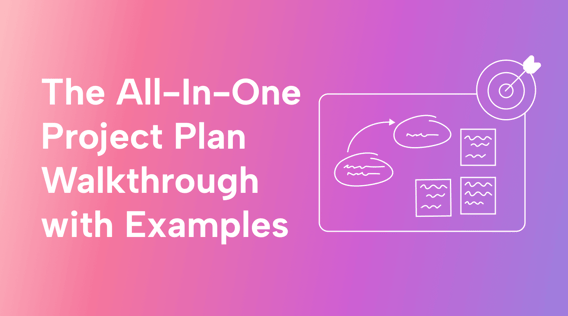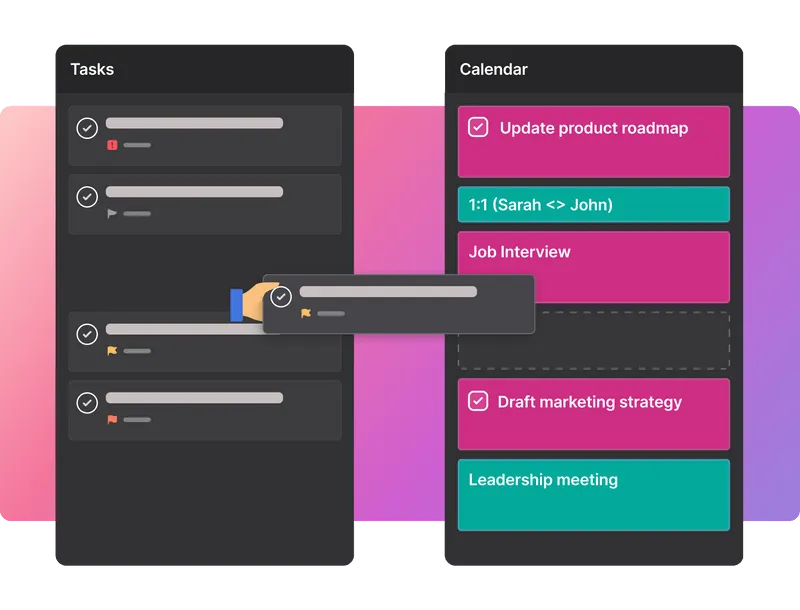Ask any good project manager , and they'll agree that a project won't succeed without a well-thought-out plan.
Could you imagine building the Burj Khalifa without a plan? How about putting someone on the moon?
Yet, according to a PMI report, 45% of projects go over time and 38% over budget.
There seems to be confusion about what a project plan looks like and using one.
To help, we'll go over how to correctly create a project plan. We'll show you examples you can use for your projects and give you tips to drive your plans to success.
What is a project plan?
A project plan is a document (and project artifact) that outlines a project's objectives and lays out the high-level process to get there. This includes the project goal, resources, and timeline. It's like a well-thought-out recipe for achieving a project's objectives.
The project plan is a result of project planning (the second phase of the PMBOK lifecycle). A project plan typically comes after (and draws information from) the project charter.
A good project plan includes the approach to the project (Agile, waterfall, or hybrid) and other important information, which we'll go over later.
Usually, a project manager prepares a project plan, but it can also be prepared by a Scrum master, CEO, product manager, or project sponsor. The project plan then guides the project manager (or whoever is leading the project) through the project lifecycle to help them achieve success.
Project plan vs. project timeline
A project plan is a full-scale plan of attack for the project, outlining all the critical steps and elements.
A project timeline is a visual representation of the chronological sequence of tasks and milestones of the project.
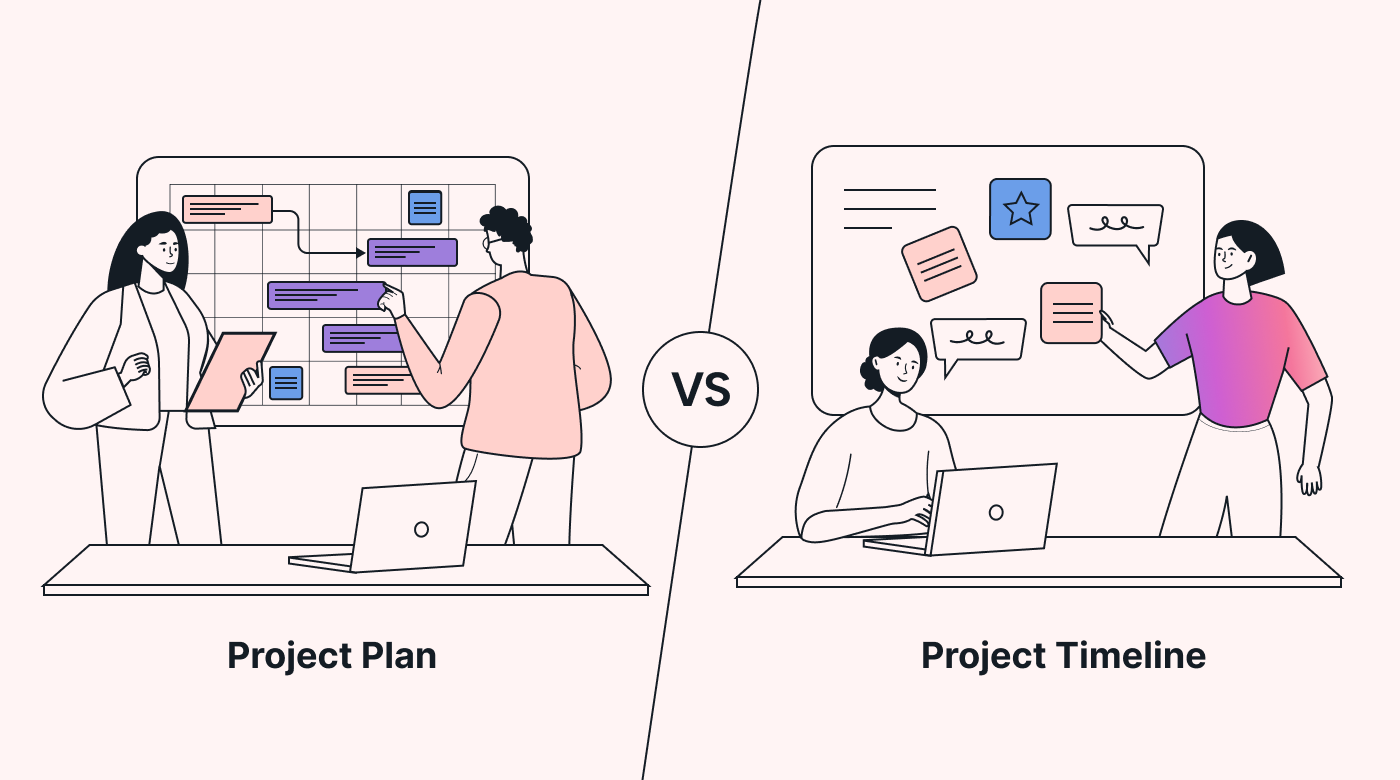 |
The timeline is good for identifying dependencies, bottlenecks, or potential task conflicts. The timeline is created during the project planning phase, and it contains critical (time-related data) for the project plan.
Benefits of a well-structured project plan
A project plan has many benefits, but the most important one is that it helps you and your team execute the project.
What can you achieve with great project plans?
- The Boeing 787 Dreamliner flies thousands of people across the planet as a prime example of an effective project plan.
- The London Olympics of 2012 owes its success to meticulous project planning.
- The first (and later) moon landings were the result of great project plans.
A project plan helps you define the initial project scope, resources, timeline, and goals. Once the project gets underway, you can compare progress against the baseline to identify deviations, delays, or scope changes.
A good project plan combines the different pieces of project management into a single document to offer a bird's-eye view of the entire project lifecycle.
Combining important project-related data in one document is also an efficiency hack, because, according to McKinsey, searching for this information piecemeal can eat up to 20% of an employee's time.
Furthermore, the clarity provided by a project plan around the important elements of a project prevents misunderstandings and aligns stakeholder expectations.
Key elements of a project plan
Simple or complex project plans contain several key elements. Each of these usually has a high-level description (or a matrix) since they are artifacts in their own right.
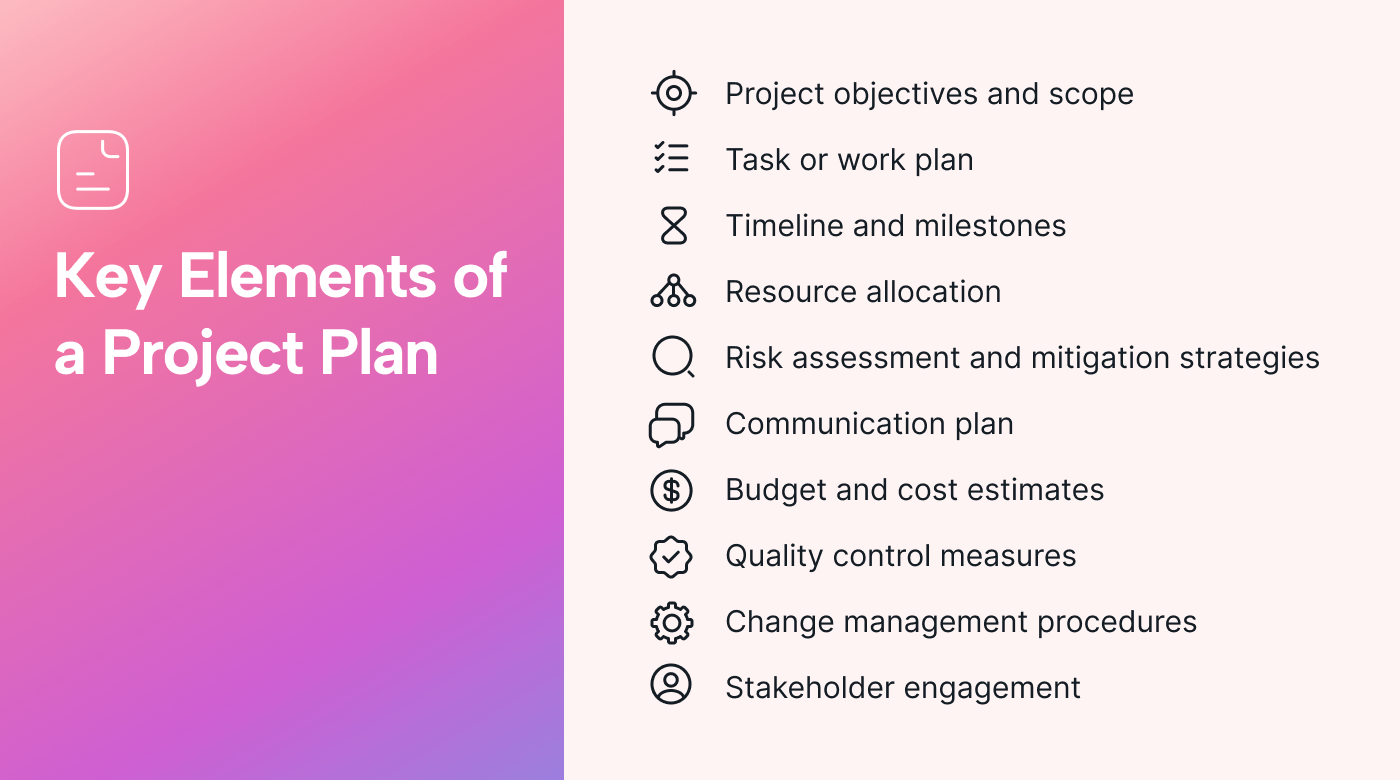 |
Here are the 10 key elements you need to include in your project plan:
- The project objectives and scope define what you aim to achieve and the boundaries of your project.
- A task plan, work plan, or work breakdown structure (WBS). These artifacts are breakdowns of your project into manageable project tasks.
- A timeline and milestones (project schedule). Outline when tasks should be completed, and milestones act as signposts to track progress.
- The resource allocation. Shows the people, time, money, and other resources your project will require.
- Risk assessment and mitigation strategies. A list of potential risks and plans to manage or mitigate their impact.
- A communication plan. Describes how you’ll keep in touch with everyone involved, about what, and the cadence.
- Project budget and cost estimates. The budget and cost estimates for each phase.
- The quality control measures. The quality standards for project deliverables and how they’ll be tested.
- Change management procedures plan how changes will be evaluated, approved, and implemented while minimizing disruptions.
- A stakeholder matrix (such as a RACI chart). Documents key stakeholders, their roles, and influence on a project.
A basic project plan example
Finding a practical and adaptable example can be challenging with all the online project plan templates. Many templates lack the real-world practicality to make them useful.
Don't fret, we've laid out some practical project plan templates to help you create your own project plan.
Project Title: New Product Launch Marketing Campaign
Project Objectives:
- Increase brand awareness for the new product by 30% within three months.
- Generate a minimum of 1,000 leads through the campaign.
- Achieve a conversion rate of 15% from leads to sales within six months.
Scope:
- Design and execute an integrated marketing campaign encompassing digital and traditional channels to create maximum impact.
- Collaborate closely with the design team to make visually appealing and consistent campaign materials.
- Hire influencers within the target audience to amplify the campaign's reach and credibility.
Key Milestones:
- Week 1-2: Finalize campaign concept and design based on market research and creative inputs.
- Week 3: Obtain necessary approvals for the campaign materials from stakeholders.
- Week 4: Launch the campaign across selected digital platforms and traditional media.
- Week 6: Conduct a mid-campaign performance review to assess engagement and adjust strategies if necessary.
- Week 8: Evaluate campaign effectiveness against predefined objectives and KPIs.
- Week 10: Prepare and present a comprehensive campaign analysis report to stakeholders.
Key Deliverables:
- Finalized campaign concept and design based on market research and creative inputs by the end of Week 2.
- Approved campaign materials from stakeholders by the end of Week 3.
- Launched campaign across selected digital platforms and traditional media by the end of Week 4.
- Mid-campaign performance review conducted by the end of Week 6 to assess engagement and adjust strategies if necessary.
- Evaluation of campaign effectiveness against predefined objectives and KPIs by the end of Week 8.
- Comprehensive campaign analysis report prepared and presented to stakeholders by Week 10.
Resources:
A. Marketing Team (4 members):
- Project Manager (Responsible for overall campaign coordination)
- Content Creator (Develops engaging written and visual content)
- Social Media Specialist (Manages online presence and engagement)
- Data Analyst (Monitors and analyzes campaign metrics)
B. Design Team (2 members):
- Graphic Designer (Creates campaign visuals and branding materials)
- Video Editor (Produces promotional videos)
Budget: $50,000 for advertising, content creation, influencer partnerships, and other campaign-related expenses.
Risk Management & Suggestion:
1. Potential delays
- Proactively plan for design revisions and content creation challenges to avoid timeline disruptions.
2. Social media algorithm changes
- Monitor platform updates and have alternative promotional strategies ready to adapt to algorithm changes.
Communication Plan:
A. Weekly team meetings
- Held every Monday to review progress, address challenges, and ensure alignment among team members.
B. Bi-weekly stakeholder updates
- Stakeholders will receive updates on campaign performance and achievements every other Friday.
What to include in an advanced project plan
Going from a basic project plan to an advanced one involves adding some elements.
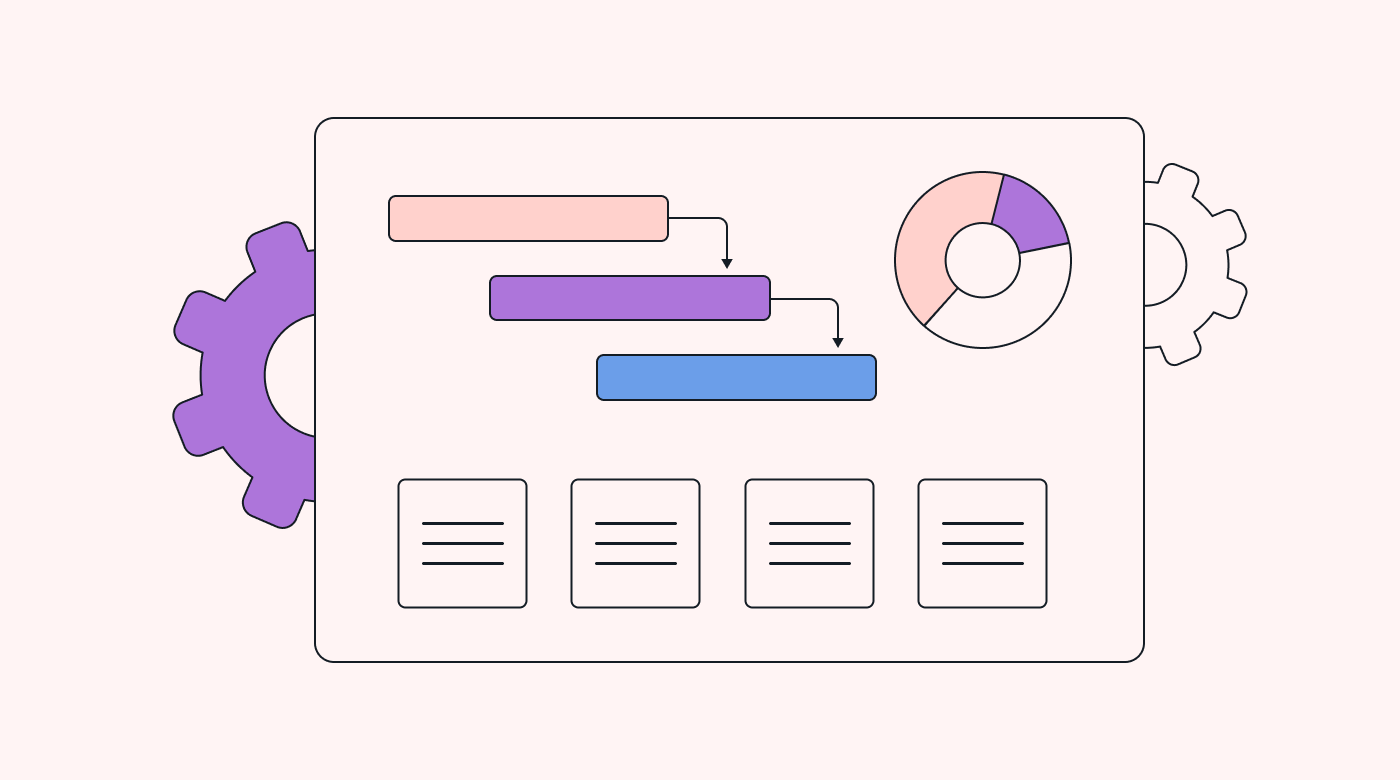 |
To adapt the basic project plan to an advanced one, add the following elements:
In scope and out of scope
Include a comprehensive breakdown of deliverables and outcomes for each project phase. Use a WBS or a product backlog to organize this information systematically.
Also, define (at a high level) what is outside the boundaries of your project. This clarification helps with scope confusion and sets realistic outcome expectations.
Risk management
While the basic project plan template has a risk management section, an advanced project plan goes into more detail.
You'll need a systematic risk assessment framework for risks across all dimensions. This includes probabilities and potential impacts of the risks and contingency plans for each.
You'll also need to outline a dynamic risk response strategy (that adapts as new risks emerge or existing ones evolve).
Stakeholder analysis
Expand your stakeholder engagement strategy with a stakeholder matrix. Detail how and when stakeholders will be engaged, adding decision points and regular progress updates.
Performance metrics
Define and track metrics and Key Performance Indicators (KPIs) for each task.
Metrics could include completion percentages, milestone achievements, and qualitative assessments.
An Agile project plan example
Agile project plans aren't as comprehensive up-front as those for traditional project management methods because of the nature of Agile.
The focus in Agile project planning is on iterative planning for Sprints (1–4 week-long work periods).
Here’s how an Agile project plan might look:
Project Purpose: New Product Launch Marketing Campaign
Sprint 1: Discovery and Concept
Duration: 2 weeks
Backlog Items:
1. Market research
- Collect data on target audience and competitors.
2. Concept brainstorm
- Collaborate with design and marketing teams to brainstorm campaign concepts.
3. Stakeholder alignment
- Meet with stakeholders to discuss initial campaign ideas.
- Capture changes and convey them to the project team.
Sprint 2: Minimum Viable Campaign (MVC)
Duration: 3 weeks
Backlog Items:
1. MVC creation
- Develop a simplified version of the campaign with core elements.
2. Content creation
- Create initial content pieces for the MVC.
3. Feedback loop
- Share MVC with stakeholders for feedback and incorporate changes.
Sprint 3: Iterative Improvements
Duration: 2 weeks
Backlog Items:
1. Iterative enhancements
- Improve campaign elements based on stakeholder feedback and team insights.
2. Design refinements
- Collaborate with the design team to enhance visual components.
3. Early engagement
- Launch MVC to a limited audience and gather engagement data.
Sprint 4: Refinement and Scaling
Duration: 3 weeks
Backlog Items:
1. Scaling strategies
- Identify opportunities to expand the campaign's reach.
2. Content diversification:
- Create additional content pieces for different platforms.
3. Data analysis
- Analyze engagement data from the early engagement phase.
Sprint 5: Adaptation and Optimization
Duration: 2 weeks
Backlog Items:
1. Adapt to feedback
- Implement changes based on engagement data and stakeholder feedback.
2. Optimization strategies
- Refine campaign elements for maximum impact.
3. Influencer engagement
- Collaborate with influencers for increased reach.
Sprint 6: Finalization and Reporting
Duration: 2 weeks
Backlog Items:
1. Final touches
- Polish campaign elements and ensure consistency.
2. Performance analysis
- Analyze the campaign's impact on brand awareness, leads, and conversions.
3. Stakeholder presentation
- Present campaign results and insights to stakeholders.
Tips, tools, and techniques for creating your own project plan
Here are some practical tips, tools, and techniques to help you create accurate and useful project plans.
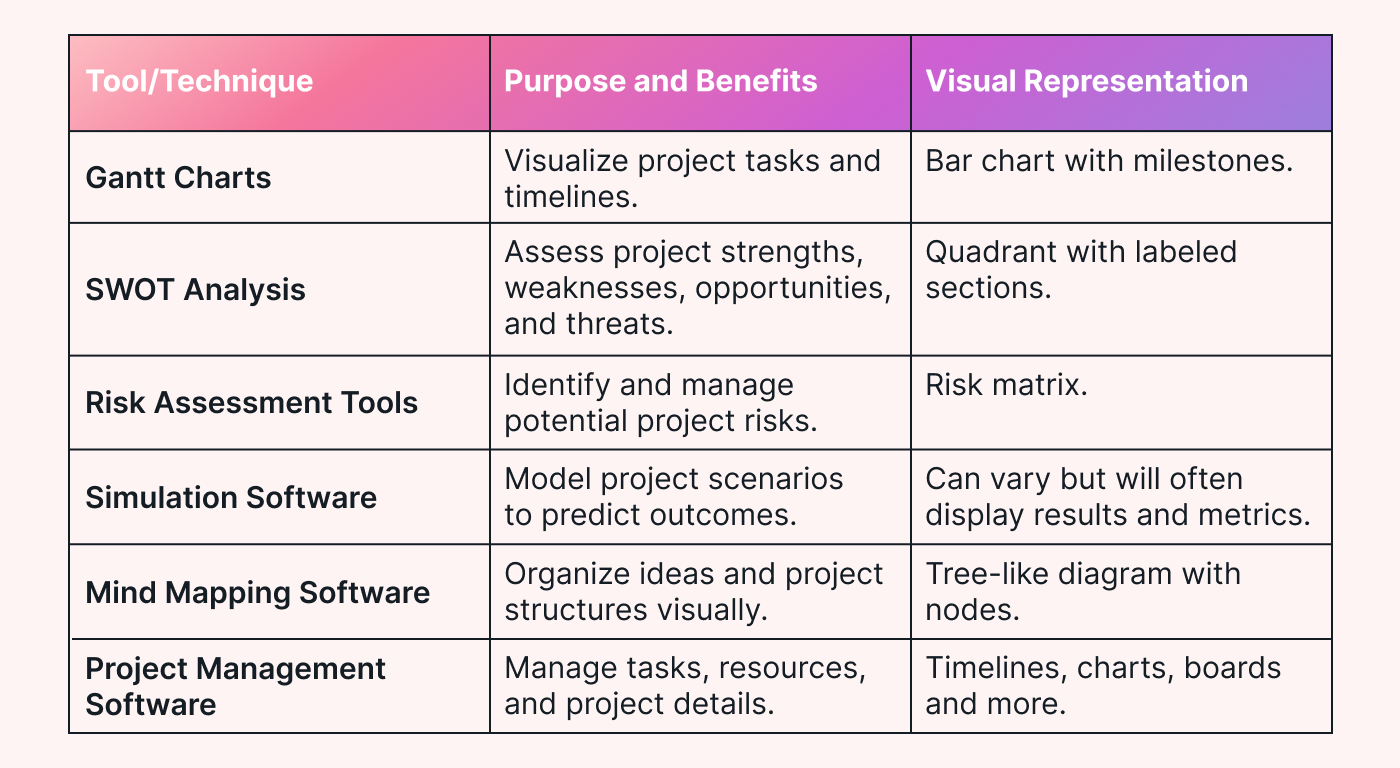 |
Reuse what you’ve already produced
Use existing resources like your project charter. Integrate the insights from your risk analysis to address potential pitfalls. Add details from your requirements assessment for a detailed view of what needs to be done.
Use visuals
Visuals can help the team and stakeholders digest and understand a project.
Use a risk matrix to visually depict potential risks, their likelihood, and their impact. Gantt charts offer an expansive view of task dependencies and timelines. A RACI (responsible, accountable, consulted, and informed) matrix defines roles and responsibilities.
Use project management software
Project management software can be a game-changer. These online platforms offer a centralized place to plan, collaborate, and track projects.
Some solutions include features like Gantt charts, timelines, and task allocation tools.
Put your project plan into action with Motion
After creating your project plan comes the next step: project execution.
To do this (and drive a successful project), it helps to visualize project plans using charts, schedules, or project boards. Motion can help you do just that with its comprehensive project planning tools.
One is its Kanban board, which allows you to see and manage your project schedule. You can adjust tasks easily within the board, and the app will rearrange dependent work to compensate.
Even better, Motion can automate task allocation.
All you have to do is create the task, assign the dates and requirements, and Motion will allocate it to your team for you. It'll notify you immediately if it can't find the best time or foresees any delays.
This just means more time for you and your team to do the work (vs. administration).
Sign up for your 7-day free trial.

